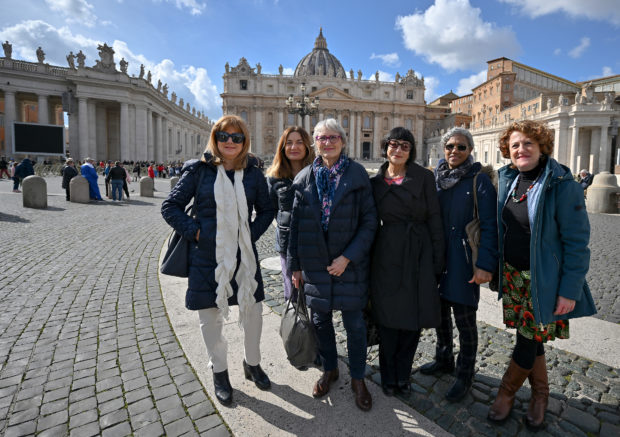Small victories as women challenge Vatican patriarchy

(L/R) Roberta Gisotti, Maria Cristina Grimaldi, Adriana Masotti, Romilda Ferrauto, Maria Dulce Araujo and Margherita M.Romanelli pose in St.Peter’s Square at the Vatican on March 6, 2023. AFP
VATICAN CITYO — Once a rare sight in the Vatican’s halls of power, women are increasingly being seen in senior posts under Pope Francis, but the gender battle is far from won.
The centuries-old institution has an inherently patriarchal image, from the Swiss Guards at the gates to the cardinals seated in St Peter’s Square.
It reflects the wider Roman Catholic Church, which outlaws divorce, abortion and the ordination of women.
Yet the pontiff’s push for reform has seen more women given roles in administrating the Vatican — even if they are mainly behind the scenes.
From economists to secretaries, historians and archivists, 649 women worked in 2019 for the Roman Curia — 24 percent of employees — compared to 385 in 2010, according to the latest available figures.
Article continues after this advertisementWhile the shift within the world’s smallest state is hailed in public, around 10 women interviewed on condition of anonymity described to AFP the resistance they meet and condescension they face, especially among clerics.
Article continues after this advertisementOne denounced “a glass ceiling and a generally paternalistic attitude in the corridors”, with a backward-looking vision of “the sensitive, gentle woman, which we find in the pope’s speeches”.
“We sometimes feel they consider us as interns. There are little gestures, a hand on the shoulder, a lack of consideration, almost daily remarks about appearance and dress,” she added.
Some described feeling subject to an implicit order for female employees to be silent and docile. Others expressed frustration at being relegated to lesser roles.
“There is still a long way to go,” one woman said.
‘Macho mentality’
In 2016, the “Women in the Vatican” association was created, a network of one hundred or so members that meet every month “to enhance the role of women”, its president Margherita Romanelli told AFP.
It followed the creation just four years earlier of a monthly women’s supplement by L’Osservatore Romano, the Vatican’s official newspaper. The surprise initiative was lauded by many, but quickly ran into trouble.
Its founder, Lucetta Scaraffia, a journalist and historian, resigned in 2019, denouncing a “climate of mistrust”.
Francis’ reforms were essentially “cosmetic” and actually concealed a “macho mentality” which implied that “women must serve without asking anything in return”, she told AFP.
Scaraffia pointed to the “modern slavery” of nuns employed in the Vatican and elsewhere as “servants” in the homes of priests, bishops or cardinals, who do the “cooking, cleaning, clothes washing” and who are “underpaid”.
And she slammed the sexual abuse of nuns in Rome and elsewhere in the world.
A voice
Despite these criticisms, many welcome the acceleration of a process quietly begun some twenty years ago.
The number of women in positions of responsibility at the Vatican — which applies strict gender wage parity — has tripled since the election of Francis 10 years ago, from Vatican Museums director Barbara Jatta to Alessandra Smerilli, the first woman to be appointed the equivalent of a deputy minister.
“The Vatican is late, but women have a voice today, they don’t let themselves be pushed around anymore,” said one official in her forties.
The head of the world’s 1.3 billion Catholics has allowed women greater involvement in masses, from being readers and altar servers to taking part in the Holy Thursday foot washing ritual.
And Francis continues to take small steps forward, including changing the rules to allow women to play a role in the appointment of bishops.
“Ten years ago, it would not have been possible to imagine such a development,” said Gudrun Sailer, an Austrian journalist with Vatican News and author of the book “Women in the Vatican”.
‘A long process’
Faced with the discrepancy between these changes and the misogyny experienced in the Vatican workplace, some women wonder what strategy to adopt.
“Some feel that the truth should be told and bad behavior should be denounced, while others think that this is counterproductive and that we should be satisfied with small steps forward,” one told AFP.
Romilda Ferrauto, a “Women in the Vatican” member, said changing mentalities was “a long process”.
“Francis’ method is to make gestures and wait for them to move the lines,” she said.
The changes within the Vatican come as the global Church engages in a vast, months-long debate over its future.
Long before the #MeToo movement, protestant churches took the lead in propelling women to the top and some theologians, such as Anne-Marie Pelletier of France, say the pope must now grasp the opportunity to move faster and more decisively.
The ordination of women as deacons or even cardinals “would be a strong symbolic gesture to erase these stereotypes”, she said.
RELATED STORIES